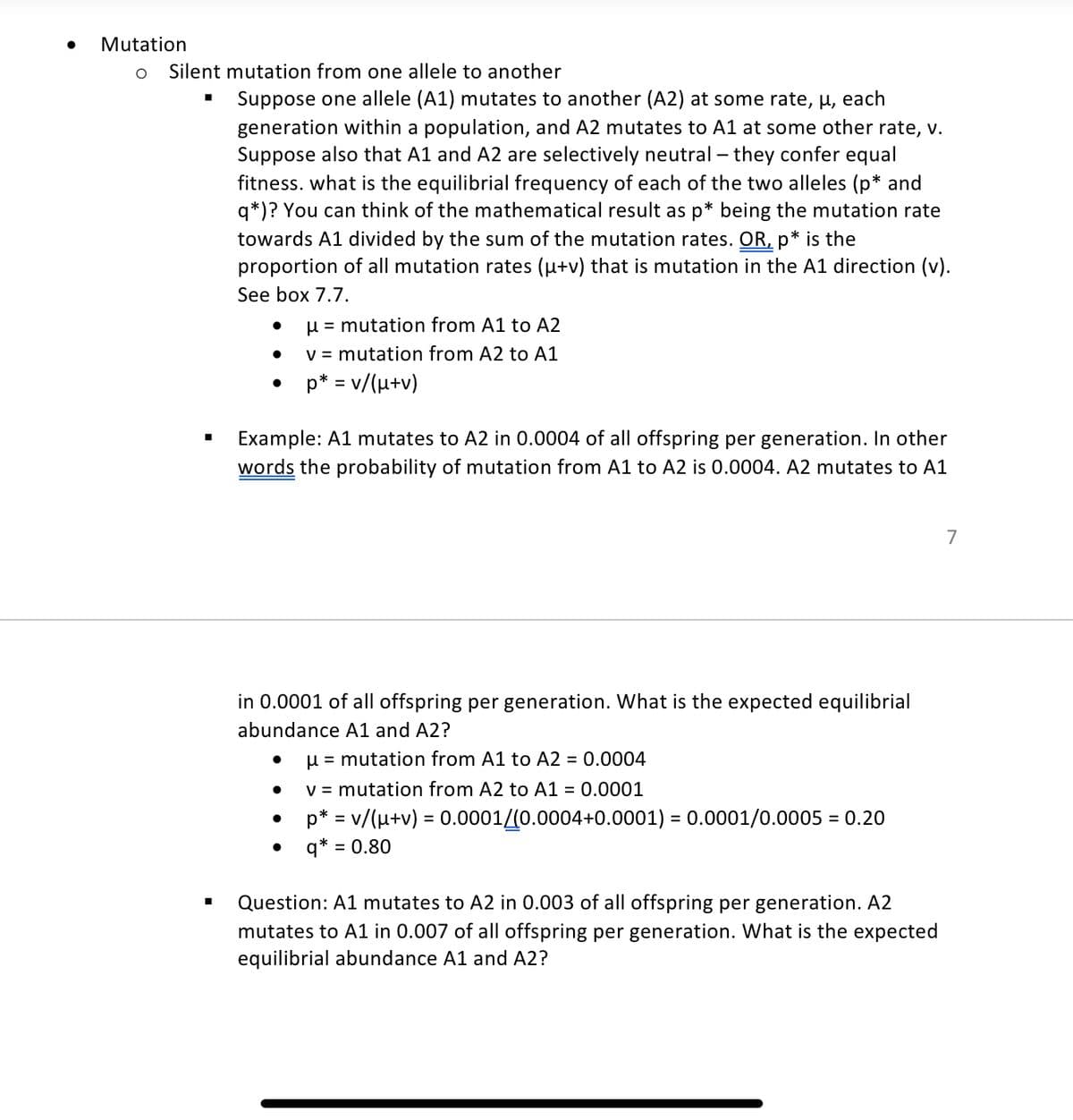Mutation O Silent mutation from one allele to another ■ Suppose one allele (A1) mutates to another (A2) at some rate, μ, each generation within a population, and A2 mutates to A1 at some other rate, v. Suppose also that A1 and A2 are selectively neutral - they confer equal fitness. what is the equilibrial frequency of each of the two alleles (p* and q*)? You can think of the mathematical result as p* being the mutation rate towards A1 divided by the sum of the mutation rates. OR, p* is the proportion of all mutation rates (µ+v) that is mutation in the A1 direction (v). See box 7.7. ● ● ● Example: A1 mutates to A2 in 0.0004 of all offspring per generation. In other words the probability of mutation from A1 to A2 is 0.0004. A2 mutates to A1 in 0.0001 of all offspring per generation. What is the expected equilibrial abundance A1 and A2? ● μ = mutation from A1 to A2 v = mutation from A2 to A1 p* = v/(μ+v) ● ● μ = mutation from A1 to A2 = 0.0004 v = mutation from A2 to A1 = 0.0001 p* = v/(μ+v) = 0.0001/(0.0004+0.0001) = 0.0001/0.0005 = 0.20 q* = 0.80 Question: A1 mutates to A2 in 0.003 of all offspring per generation. A2 mutates to A1 in 0.007 of all offspring per generation. What is the expected equilibrial abundance A1 and A2? 7
Mutation O Silent mutation from one allele to another ■ Suppose one allele (A1) mutates to another (A2) at some rate, μ, each generation within a population, and A2 mutates to A1 at some other rate, v. Suppose also that A1 and A2 are selectively neutral - they confer equal fitness. what is the equilibrial frequency of each of the two alleles (p* and q*)? You can think of the mathematical result as p* being the mutation rate towards A1 divided by the sum of the mutation rates. OR, p* is the proportion of all mutation rates (µ+v) that is mutation in the A1 direction (v). See box 7.7. ● ● ● Example: A1 mutates to A2 in 0.0004 of all offspring per generation. In other words the probability of mutation from A1 to A2 is 0.0004. A2 mutates to A1 in 0.0001 of all offspring per generation. What is the expected equilibrial abundance A1 and A2? ● μ = mutation from A1 to A2 v = mutation from A2 to A1 p* = v/(μ+v) ● ● μ = mutation from A1 to A2 = 0.0004 v = mutation from A2 to A1 = 0.0001 p* = v/(μ+v) = 0.0001/(0.0004+0.0001) = 0.0001/0.0005 = 0.20 q* = 0.80 Question: A1 mutates to A2 in 0.003 of all offspring per generation. A2 mutates to A1 in 0.007 of all offspring per generation. What is the expected equilibrial abundance A1 and A2? 7
Biology: The Unity and Diversity of Life (MindTap Course List)
14th Edition
ISBN:9781305073951
Author:Cecie Starr, Ralph Taggart, Christine Evers, Lisa Starr
Publisher:Cecie Starr, Ralph Taggart, Christine Evers, Lisa Starr
Chapter26: Human Evolution
Section: Chapter Questions
Problem 2DAA: Neanderthal Hair Color The MCIR gene regulates pigmentation in humans (Sections 14.1 and 15.l...
Related questions
Topic Video
Question

Transcribed Image Text:Mutation
O Silent mutation from one allele to another
■
Suppose one allele (A1) mutates to another (A2) at some rate, μ, each
generation within a population, and A2 mutates to A1 at some other rate, v.
Suppose also that A1 and A2 are selectively neutral - they confer equal
fitness. what is the equilibrial frequency of each of the two alleles (p* and
q*)? You can think of the mathematical result as p* being the mutation rate
towards A1 divided by the sum of the mutation rates. OR, p* is the
proportion of all mutation rates (µ+v) that is mutation in the A1 direction (v).
See box 7.7.
●
●
●
μ = mutation from A1 to A2
v = mutation from A2 to A1
p* = v/(μ+v)
Example: A1 mutates to A2 in 0.0004 of all offspring per generation. In other
words the probability of mutation from A1 to A2 is 0.0004. A2 mutates to A1
in 0.0001 of all offspring per generation. What is the expected equilibrial
abundance A1 and A2?
μ = mutation from A1 to A2 = 0.0004
v = mutation from A2 to A1 = 0.0001
p* = v/(μ+v) = 0.0001/(0.0004+0.0001) = 0.0001/0.0005 = 0.20
● q* = 0.80
●
Question: A1 mutates to A2 in 0.003 of all offspring per generation. A2
mutates to A1 in 0.007 of all offspring per generation. What is the expected
equilibrial abundance A1 and A2?
7
Expert Solution
This question has been solved!
Explore an expertly crafted, step-by-step solution for a thorough understanding of key concepts.
Step by step
Solved in 3 steps with 6 images

Knowledge Booster
Learn more about
Need a deep-dive on the concept behind this application? Look no further. Learn more about this topic, biology and related others by exploring similar questions and additional content below.Recommended textbooks for you

Biology: The Unity and Diversity of Life (MindTap…
Biology
ISBN:
9781305073951
Author:
Cecie Starr, Ralph Taggart, Christine Evers, Lisa Starr
Publisher:
Cengage Learning

Human Heredity: Principles and Issues (MindTap Co…
Biology
ISBN:
9781305251052
Author:
Michael Cummings
Publisher:
Cengage Learning

Biology (MindTap Course List)
Biology
ISBN:
9781337392938
Author:
Eldra Solomon, Charles Martin, Diana W. Martin, Linda R. Berg
Publisher:
Cengage Learning

Biology: The Unity and Diversity of Life (MindTap…
Biology
ISBN:
9781305073951
Author:
Cecie Starr, Ralph Taggart, Christine Evers, Lisa Starr
Publisher:
Cengage Learning

Human Heredity: Principles and Issues (MindTap Co…
Biology
ISBN:
9781305251052
Author:
Michael Cummings
Publisher:
Cengage Learning

Biology (MindTap Course List)
Biology
ISBN:
9781337392938
Author:
Eldra Solomon, Charles Martin, Diana W. Martin, Linda R. Berg
Publisher:
Cengage Learning

Biology Today and Tomorrow without Physiology (Mi…
Biology
ISBN:
9781305117396
Author:
Cecie Starr, Christine Evers, Lisa Starr
Publisher:
Cengage Learning